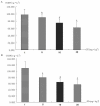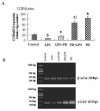Polydatin up-regulates Clara cell secretory protein to suppress phospholipase A2 of lung induced by LPS in vivo and in vitro
- PMID: 21787397
- PMCID: PMC3199855
- DOI: 10.1186/1471-2121-12-31
Polydatin up-regulates Clara cell secretory protein to suppress phospholipase A2 of lung induced by LPS in vivo and in vitro
Abstract
Background: Lung injury induced by lipopolysaccharide (LPS) remains one of the leading causes of morbidity and mortality in children. The damage to membrane phospholipids leads to the collapse of the bronchial alveolar epithelial barrier during acute lung injury (ALI)/acute respiratory distress syndrome (ARDS). Phospholipase A2 (PLA2), a key enzyme in the hydrolysis of membrane phospholipids, plays an important traumatic role in pulmonary inflammation, and Clara cell secretory protein (CCSP) is an endogenous inhibitor of PLA2. Our previous study showed that polydatin (PD), a monocrystalline extracted from a traditional Chinese medicinal herb (Polygonum cuspidatum Sieb, et Zucc), reduced PLA2 activity and sPLA2-IIA mRNA expression and mitigated LPS-induced lung injury. However, the potential mechanism for these effects has not been well defined. We have continued to investigate the effect of PD on LPS-induced expression of CCSP mRNA and protein in vivo and in vitro.
Results: Our results suggested that the CCSP mRNA level was consistent with its protein expression. CCSP expression was decreased in lung after LPS challenge. In contrast, PD markedly increased CCSP expression in a concentration-dependent manner. In particular, CCSP expression in PD-pretreated rat lung was higher than in rats receiving only PD treatment.
Conclusion: These results indicated that up-regulation of CCSP expression causing inhibition of PLA2 activation may be one of the crucial protective mechanisms of PD in LPS-induced lung injury.
Figures












Similar articles
-
The role of C/EBPβ phosphorylation in modulating membrane phospholipids repairing in LPS-induced human lung/bronchial epithelial cells.Gene. 2017 Sep 20;629:76-85. doi: 10.1016/j.gene.2017.07.076. Epub 2017 Jul 29. Gene. 2017. PMID: 28760550 Free PMC article.
-
Clara cell secretory protein and phospholipase A2 activity modulate acute ventilator-induced lung injury in mice.J Appl Physiol (1985). 2005 Apr;98(4):1264-71. doi: 10.1152/japplphysiol.01150.2004. Epub 2004 Dec 17. J Appl Physiol (1985). 2005. PMID: 15608088
-
Effects of sevoflurane on pulmonary cytosolic phospholipase A₂ and clara cell secretory protein expressions in rabbits with one-lung ventilation-induced lung injury.Nan Fang Yi Ke Da Xue Xue Bao. 2013 Apr;33(4):469-73. Nan Fang Yi Ke Da Xue Xue Bao. 2013. PMID: 23644101
-
Tumor necrosis factor alpha stimulation of human Clara cell secretory protein production by human airway epithelial cells.Ann N Y Acad Sci. 2000;923:193-201. doi: 10.1111/j.1749-6632.2000.tb05530.x. Ann N Y Acad Sci. 2000. PMID: 11193757 Review.
-
Regulation of the Clara cell secretory protein/uteroglobin promoter in lung.Ann N Y Acad Sci. 2000;923:154-65. doi: 10.1111/j.1749-6632.2000.tb05527.x. Ann N Y Acad Sci. 2000. PMID: 11193754 Review.
Cited by
-
CC16 augmentation reduces exaggerated COPD-like disease in Cc16-deficient mice.JCI Insight. 2023 Mar 22;8(6):e130771. doi: 10.1172/jci.insight.130771. JCI Insight. 2023. PMID: 36787195 Free PMC article.
-
Retinoic acid promotes the endogenous repair of lung stem/progenitor cells in combined with simvastatin after acute lung injury: a stereological analysis.Respir Res. 2015 Nov 11;16:140. doi: 10.1186/s12931-015-0300-9. Respir Res. 2015. PMID: 26561298 Free PMC article.
-
Inhibitory Effects of Polydatin on Lipopolysaccharide-Stimulated RAW 264.7 Cells.Inflammation. 2015;38(3):1213-20. doi: 10.1007/s10753-014-0087-8. Inflammation. 2015. PMID: 25567371
-
Sex differences in vanadium inhalation effects in non-ciliated bronchiolar cells.Histol Histopathol. 2023 Jul;38(7):765-777. doi: 10.14670/HH-18-566. Epub 2022 Nov 30. Histol Histopathol. 2023. PMID: 36524411
-
The Invasive Species Reynoutria japonica Houtt. as a Promising Natural Agent for Cardiovascular and Digestive System Illness.Front Pharmacol. 2022 Jun 13;13:863707. doi: 10.3389/fphar.2022.863707. eCollection 2022. Front Pharmacol. 2022. PMID: 35770098 Free PMC article.
References
-
- Kitsiouli E, Nakos G, Lekka ME. Phospholipase A2 subclasses in acute respiratory distress syndrome. Biochim Biophys Acta. 2009;1792(10):941–953. - PubMed
-
- Wu Y, Singer M, Thouron F, Alaoui-El-Azher M, Touqui L. Effect of surfactant on pulmonary expression of type IIA PLA(2) in an animal model of acute lung injury. Am J Physiol Lung Cell Mol Physiol. 2002;282(4):L743–750. - PubMed
Publication types
MeSH terms
Substances
LinkOut - more resources
Full Text Sources
Molecular Biology Databases

